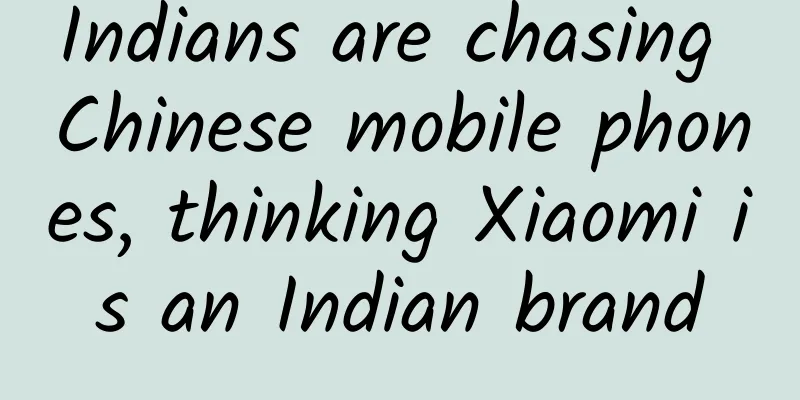Indians are chasing Chinese mobile phones, thinking Xiaomi is an Indian brand

|
According to a report on May 2, foreign media reported that Chinese mobile phone manufacturers have been aggressively entering India since 2013 and have achieved amazing results in a short period of time, not only encroaching on the territory of international brands such as Samsung and LG from South Korea, but also grabbing the market share of local Indian mobile phones. According to the Indian mobile phone market report just released by the International Data Corporation (IDC), the market share of Chinese mobile phones in India has increased from 5% in 2013 to 22% today. According to a report by Voice of America on its website on April 29, the Indian fashion magazine Outlook published an investigative article titled "From China, with Love", analyzing why Chinese mobile phones are popular among consumers, especially young people, in the Indian market. The article quoted Kuldeep Chengappa, a scientist in Bangalore, as saying, "Chinese mobile phones offer competitive features and are cheap, making them an obvious choice." According to the report, India has surpassed the United States to become the world's second largest smartphone market after China, with 220 million users. As the Chinese mobile phone market becomes increasingly saturated, Chinese mobile phone manufacturers have stepped up their efforts to expand overseas markets, and India has become their first choice. Reporters can see advertisements or stores of Chinese mobile phones such as Lenovo, Xiaomi, OPPO, and Huawei everywhere in various cities in India, and some Indian consumers interviewed randomly also have high opinions of Chinese mobile phones. Most of the mobile phone models launched by these Chinese manufacturers in India are priced between US$100 and US$300, which is lower than the prices of international brands such as Samsung and Apple, and different from local Indian mobile phones that are mainly promoted in the low-end market below US$100. However, price positioning is not the only advantage of Chinese mobile phones. Tarun Pathak, a designer at market research company Counterpoint Research, believes that "Chinese brands' smartphones have made significant improvements in hardware design, software flexibility, and user interface (UI) integration. In addition, they are also very active in market launch and grasping product trends." For example, international brands such as Samsung and Apple often pre-install a lot of software in their phones, but this does not conform to the habits of Indian consumers, who like to load or uninstall apps (third-party application software on smartphones) at will. Chinese phones mostly provide them with this convenience and rarely force the installation of things that consumers think are useless. The report said that Chinese mobile phone companies also carefully designed their brand image and positioning. For example, Xiaomi claimed that 75% of its mobile phone components come from India, fully responding to the "Make in India" national strategy promoted by Indian Prime Minister Modi after he came to power. Even its advertisements used the very friendly slogan "Mi from India", so that some Indian consumers believed that Xiaomi was a local Indian brand. Allen, a Chinese manager from Shenzhen who set up a mobile phone parts company in Kolkata, told reporters: "75% is unlikely at the moment. Most Chinese mobile phone manufacturers still bring domestic material parts to India for assembly. This is called semi-knocked-down (SKD)." In the past few years of development, Chinese mobile phone companies have established a relatively complete supply chain in China. Some local Indian mobile phones actually use parts purchased in China and assembled in India. The report said that although Chinese mobile phone manufacturers have been making great strides in India, like other Chinese-made products entering overseas markets, these mobile phone companies will more or less encounter some special local problems. Xiaomi mobile phones were briefly banned by the Indian government in 2014 due to a patent lawsuit between it and Ericsson. It seems that the Indian government is willing to make a "fair ruling" at least in patent disputes with foreign manufacturers (there are also many infringement incidents involving local Indian companies, and most of the time, the Indian government does not take any measures against them). In addition, according to the Times of India, the Indian government also announced last week that it would ban the import of some Chinese mobile phones on the grounds that these phones "do not have the International Identity for Mobile Devices and lack some security features required by the Indian government." However, in general, Chinese mobile phones have made a name for themselves in India. Pankaj Mohindroo of the Indian Mobile Industry Association said that Chinese mobile phone manufacturers have learned from the lessons of other Chinese industries entering the international market and can compete with international brands in terms of product quality and after-sales service: "In the field of smartphones, they have helped Indian consumers eliminate the negative impression of 'Made in China' in the past." As a winner of Toutiao's Qingyun Plan and Baijiahao's Bai+ Plan, the 2019 Baidu Digital Author of the Year, the Baijiahao's Most Popular Author in the Technology Field, the 2019 Sogou Technology and Culture Author, and the 2021 Baijiahao Quarterly Influential Creator, he has won many awards, including the 2013 Sohu Best Industry Media Person, the 2015 China New Media Entrepreneurship Competition Beijing Third Place, the 2015 Guangmang Experience Award, the 2015 China New Media Entrepreneurship Competition Finals Third Place, and the 2018 Baidu Dynamic Annual Powerful Celebrity. |
<<: Yu Yongfu: Upgrading UC Browser along the transformation path of Taobao Mobile
>>: 'Lord of the Rings' director: Mixed reality will replace mobile phones
Recommend
NIO receives RMB 7 billion investment and moves its headquarters to Hefei
Affected by the epidemic, the new energy market i...
The ROI dilemma of B-side enterprise marketing!
China's Internet industry has been developing...
What are the things to pay attention to when leasing IDC large bandwidth?
What are the things to pay attention to when leas...
Summary of the first day of ChinaJoy: Consoles are here, mobile games have changed
Although the main course of ChinaJoy is today'...
Sony MDR-1000X pushes BOSE off the altar to create the most powerful Bluetooth noise reduction
When it comes to noise-canceling headphones, many...
Why do I see this strange phenomenon when I go to Finland?
In Finland, you can always see some very strange ...
Smart home: The battle over standards will leave corpses everywhere
Under the background of the new normal of the eco...
Sea Fog: I am not an ordinary fog!
Produced by: Science Popularization China Author:...
How can new media operators correctly follow hot topics?
There is nothing wrong with chasing hot topics , ...
Four ways to update UI asynchronously on Android
As we all know, due to performance requirements, ...
Internet + The next hot spot in the film and television industry
In the era of mobile Internet, film and televisio...
C919 obtains type certificate!
This year, domestic tourists may have a chance Th...
A new drug for postpartum depression has taken a big step forward! What is so new about it?
After the new drug is launched, it can be expecte...
What are the "black and white holes" on the road? You can't just hide from them!
Tunnel entrance and exit sections Why do accident...
What issues should be paid attention to when editing Baidu Encyclopedia, so as to create Baidu Encyclopedia entries 100% successfully?
What issues should be paid attention to when edit...









